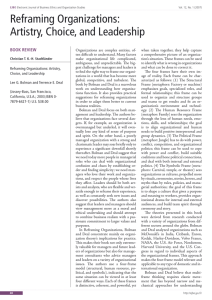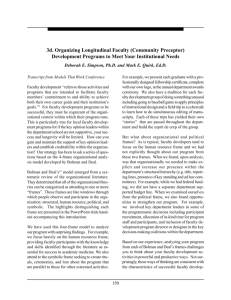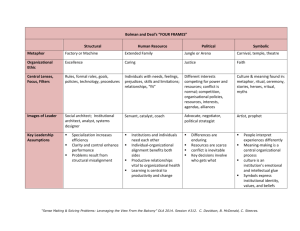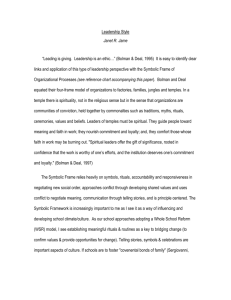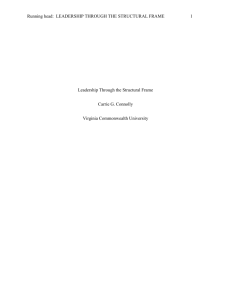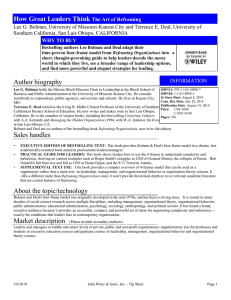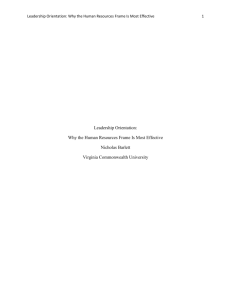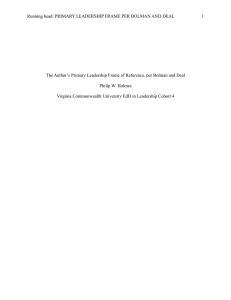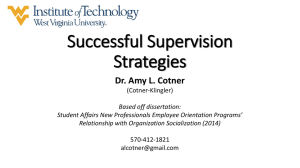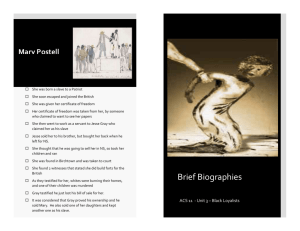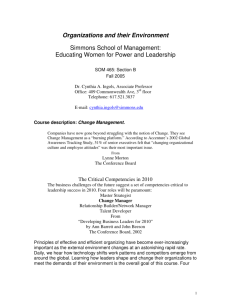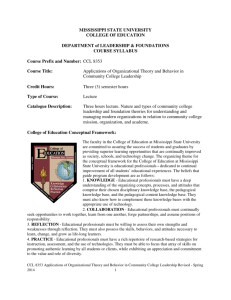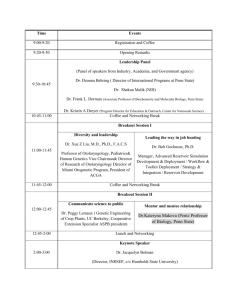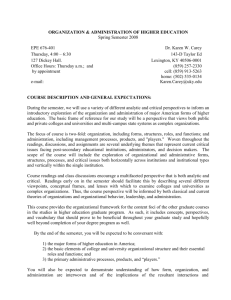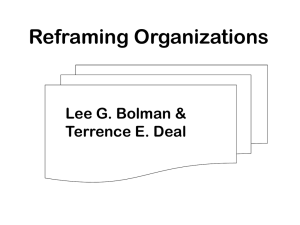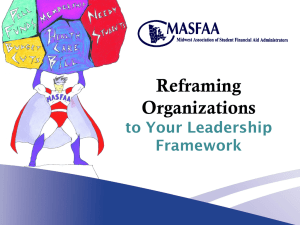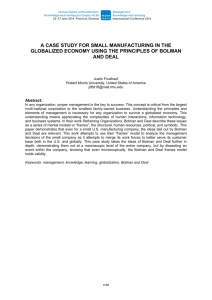Bolman & Deal`s Four-Frame Model
advertisement
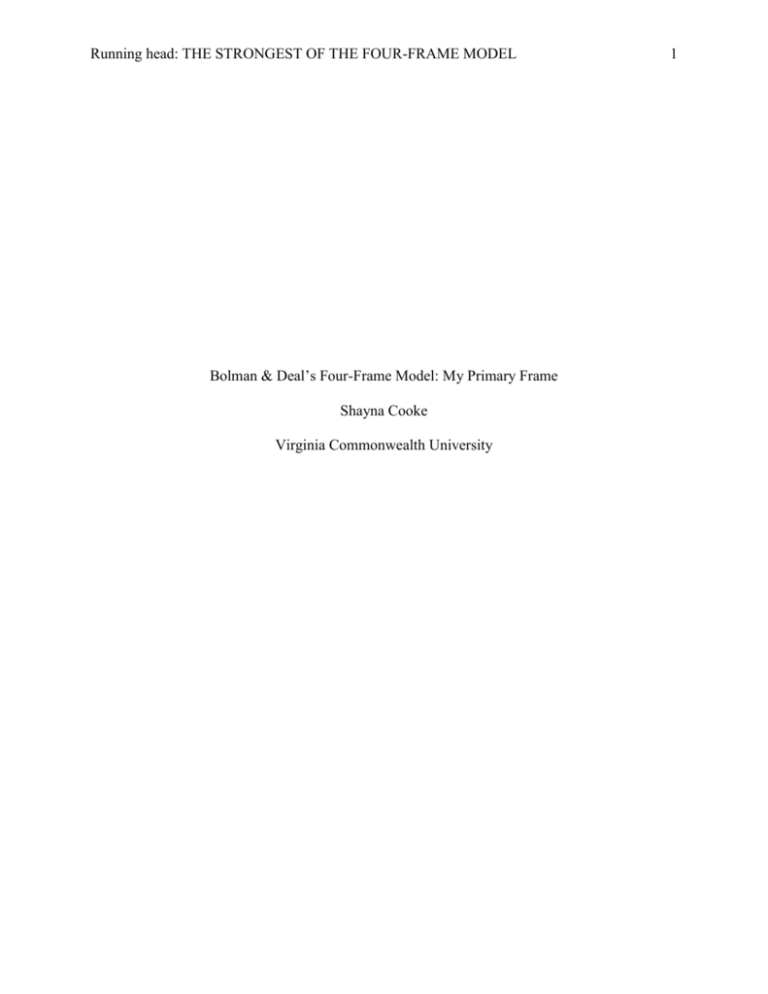
Running head: THE STRONGEST OF THE FOUR-FRAME MODEL Bolman & Deal’s Four-Frame Model: My Primary Frame Shayna Cooke Virginia Commonwealth University 1 THE STRONGEST OF THE FOUR-FRAME MODEL 2 The Strongest of the Four-Frame Model In 1984, Lee Bolman and Terrence Deal sought to express a simplistic, yet comprehensive, model of leadership that would be viewed as “useful knowledge”, (Bolman & Deal, 2013, p. 14) for individuals searching for methods to become successful at leading organizations. After much research on the subject, Bolman and Deal determined that leadership of organizations could be described and sorted into four major frames – Structural, Human Resource, Political, and Symbolic (Bolman & Deal, 1984). The Structural Frame gives insight on viewing a business from a rational angle, focusing on organization, planning, goals, structure, and coordination. The Structural Frame best aligns with individuals that have a use-first of Precision and Sequence on the Learning Connections Inventory. Rules, policies, and procedures are a thoughtful outcome of leadership with the Structural Frame (Bolman & Deal, 2013). Human Resources, as a Frame, focuses on the people involved and the relationships intertwined with those people. A leader that pulls from the Human Resources Frame sees any organization as a larger family, all working toward a collective goal. Every individual is recognized for his/her own thoughts and ideas (Bolman & Deal, 2013). If a leader were most comfortable commanding from a place of power, he/she would find themselves functioning within the Political Frame. Leaders favoring a Political Frame can be found working both angles of a conflict without committing to either, in hopes of getting support of parties on both sides of the issue (Bolman & Deal, 2013). Finally, the Frame that draws emphasis on “culture, symbols, or spirit”(Bolman & Deal, 2013, p. 16) for organizational success is the Symbolic Frame, and focuses heavily on emotional attachment to ideas and goals rather than rules and policies or authoritative figures. THE STRONGEST OF THE FOUR-FRAME MODEL 3 After careful review of these four frames, and some introspection, I believe that my primary frame of leadership stems from Human Resources. My strongest characteristic of self is empathy and human connection. When placed in given situations, I find myself leading with “lateral techniques” (Bolman & Deal, 2013, p. 54) and driving success from within the organization or group, rather than out front. Part of what makes me a strong educator is the fact that I recognize human needs and am an excellent read of character. I can look at my students, and in an instant, I can see where they are in their own sense of self. This character trait allows me to modify my lessons and plans, in an instant, to reflect the mood of the room. Rather than dragging my students along my steadfast plan each day, I meet them where they are and we move together. I attribute my success as an educator to this quality, which, when dealing with adolescents, is essential. Working from a Human Resources Frame has helped me to be a good Mentor Teacher to new, incoming teachers. If I were to use a Structural Frame as my use–first trait, I would intimidate new teachers by overwhelming them with emphasis on structure of classroom and policy of organization. Working with new teachers from a Human Resources perspective, I am able to look at each teacher as an individual and address each person’s needs independently. This allows me to embrace the strengths of each new teacher and celebrate these while addressing any shortcomings or inadequacies. The result, I believe, is an individual that feels validated as they learn to hone their craft in a safe and warm environment. I utilized my strengths within the Human Resources Frame this year when I organized a Project-Based Learning (PBL) Cohort, JK-12, at Collegiate. PBL is a proven method of teaching that creates authentic learning experiences for students and enhances learning in a way that traditional classroom teaching never has. The problem however, is that switching curriculum THE STRONGEST OF THE FOUR-FRAME MODEL 4 from a traditional classroom to one that utilizes PBL activities involves a leap of faith and can be quite scary and intimidating. I am a true believer in this type of education and believe that every student should be exposed to these types of critical thinking skills. Because of this, I created a PBL Cohort this year that serves as a committee of educators that are willing to try, and to fail at, this type of teaching. Though I created this Cohort, I am most definitely leading from within and coming from a place that celebrates any trial, and failure, because it shows growth and determination. I would rather teachers try to facilitate learning in new ways, even if it doesn’t work, rather than perpetuate the old idea that standing in front of the class and lecturing is a successful means of teaching. I believe that a skillful leader knows how and when to engage each one of Bolman & Deal’s Four-Frame Model and I am working on that aspect of my leadership. I can most definitely pull in the Structural Frame through my Sequence and Precision (LCI) use-firsts, I am solid with my Human Resources Frame, but, as a scientist, I struggle with the Symbolic Frame because I have been trained to see things for what they are, not for the ceremony of it. People cling to symbolism however, and I think it will be a very valuable leadership characteristic to develop. I also struggle with the Political Frame and this is something that I am working on constantly. Because I am an empathetic person who arguably feels too much, I find myself getting overly passionate about issues and I need to learn to sit back, listen, take a moment to see the situation from all angles, and respond in a measured and thoughtful manner. Bolman & Deal’s Four-Frame Model shows that truly effective leaders need to be able to use multiple perspectives with any issue to appear poised and collected. The ability to navigate between these frames will instill confidence in leadership abilities from the organization and ensure support of the leader and the administration. THE STRONGEST OF THE FOUR-FRAME MODEL References Bolman, L. & Deal, T. (2013). Reframing organization, 5th edition. San Francisco, CA: JosseyBass. 5
